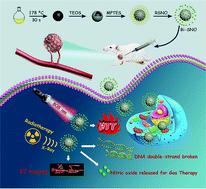Our official English website, www.x-mol.net, welcomes your feedback! (Note: you will need to create a separate account there.)
X-ray-triggered NO-released Bi-SNO nanoparticles: all-in-one nano-radiosensitizer with photothermal/gas therapy for enhanced radiotherapy.
Nanoscale ( IF 6.7 ) Pub Date : 2020-08-31 , DOI: 10.1039/d0nr04634e Fangmei Zhang 1 , Shikai Liu 1 , Na Zhang 2 , Ye Kuang 1 , Wenting Li 1 , Shili Gai 1 , Fei He 1 , Arif Gulzar 1 , Piaoping Yang 1
Nanoscale ( IF 6.7 ) Pub Date : 2020-08-31 , DOI: 10.1039/d0nr04634e Fangmei Zhang 1 , Shikai Liu 1 , Na Zhang 2 , Ye Kuang 1 , Wenting Li 1 , Shili Gai 1 , Fei He 1 , Arif Gulzar 1 , Piaoping Yang 1
Affiliation

|
Hypoxia in tumor cells is regarded as the most crucial cause of clinical drug resistance and radio-resistance; thus, relieving hypoxia of tumor cells is the key to enhancing the efficacy of anticancer therapy. As a gas signal molecule of vasodilatation factors, nitric oxide (NO) can relieve the hypoxia status of tumor cells, thereby, enhancing the sensitivity of tumor cells to radiotherapy. However, considering complications of vascular activity, the level of NO required for radiotherapy sensitization cannot be obtained in vivo. In view of this, we design and fabricate a multifunctional bismuth-based nanotheranostic agent, which is functionalized with S-nitrosothiol and termed Bi–SNO NPs. X-rays break down the S–N bond and simultaneously trigger large amount of NO-releasing (over 60 μM). Moreover, the as-prepared Bi–SNO NPs not only possess the capability of absorbing and converting 808 nm NIR photons into heat for photothermal therapy, but also have the ability to increase X-ray absorption and CT imaging sensitivity. In addition, the collaborative radio-, photothermal-, and gas-therapy of Bi–SNO in vivo was further investigated and remarkable synergistic tumor inhibition was realized. Finally, no obvious toxicity of Bi–SNO NPs was observed in the treated mice within 14 days. Therefore, the Bi–SNO developed in this work is an effective nano-agent for cancer theranostics with well-controlled morphology and uniform size (36 nm), which could serve as a versatile CT imaging-guided combined radio-, photothermal- and gas-therapy nanocomposite with negligible side effects.
中文翻译:

X射线触发NO释放的Bi-SNO纳米粒子:具有光热/气体疗法的多合一纳米放射增敏剂,用于增强放射疗法。
肿瘤细胞缺氧被认为是临床耐药性和放射抗性的最关键原因。因此,减轻肿瘤细胞的缺氧是增强抗癌治疗效果的关键。作为血管舒张因子的气体信号分子,一氧化氮(NO)可以缓解肿瘤细胞的缺氧状态,从而增强肿瘤细胞对放射疗法的敏感性。然而,考虑到血管活动的并发症,无法在体内获得放射疗法致敏所需的NO水平。有鉴于此,我们设计并制造了一种多功能的基于铋的纳米热敏剂,该剂可以用S-亚硝基硫醇官能化并称为Bi-SNO NP。X射线破坏了S–N键,并同时引发大量的NO释放(超过60μM)。而且,所制备的Bi-SNO NPs不仅具有吸收和转换808 nm NIR光子并将其转化为热进行光热治疗的能力,而且还具有提高X射线吸收和CT成像灵敏度的能力。此外,Bi-SNO在体内的协同放射,光热和气体疗法进一步研究并实现了显着的协同肿瘤抑制作用。最后,在治疗后的14天内,没有观察到Bi-SNO NP的明显毒性。因此,在这项工作中开发的Bi–SNO是一种有效的癌症治疗学纳米剂,具有形态学可控且尺寸均匀(36 nm),可作为多功能CT成像引导的放射,光热和气体组合疗法的纳米复合材料,副作用可忽略不计。
更新日期:2020-10-02
中文翻译:

X射线触发NO释放的Bi-SNO纳米粒子:具有光热/气体疗法的多合一纳米放射增敏剂,用于增强放射疗法。
肿瘤细胞缺氧被认为是临床耐药性和放射抗性的最关键原因。因此,减轻肿瘤细胞的缺氧是增强抗癌治疗效果的关键。作为血管舒张因子的气体信号分子,一氧化氮(NO)可以缓解肿瘤细胞的缺氧状态,从而增强肿瘤细胞对放射疗法的敏感性。然而,考虑到血管活动的并发症,无法在体内获得放射疗法致敏所需的NO水平。有鉴于此,我们设计并制造了一种多功能的基于铋的纳米热敏剂,该剂可以用S-亚硝基硫醇官能化并称为Bi-SNO NP。X射线破坏了S–N键,并同时引发大量的NO释放(超过60μM)。而且,所制备的Bi-SNO NPs不仅具有吸收和转换808 nm NIR光子并将其转化为热进行光热治疗的能力,而且还具有提高X射线吸收和CT成像灵敏度的能力。此外,Bi-SNO在体内的协同放射,光热和气体疗法进一步研究并实现了显着的协同肿瘤抑制作用。最后,在治疗后的14天内,没有观察到Bi-SNO NP的明显毒性。因此,在这项工作中开发的Bi–SNO是一种有效的癌症治疗学纳米剂,具有形态学可控且尺寸均匀(36 nm),可作为多功能CT成像引导的放射,光热和气体组合疗法的纳米复合材料,副作用可忽略不计。


























 京公网安备 11010802027423号
京公网安备 11010802027423号